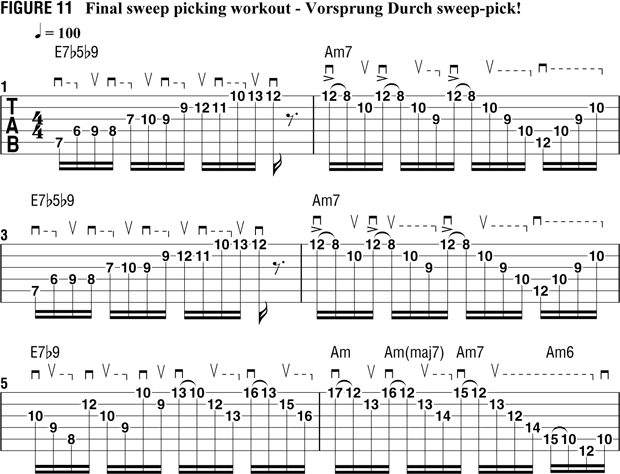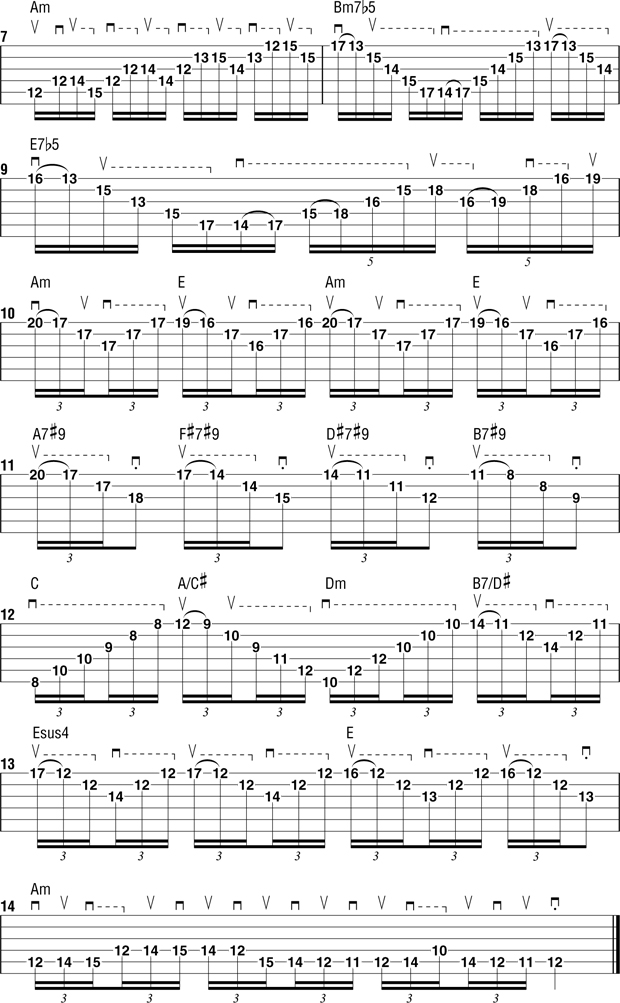Sweep picking: how to get started with this awe-inspiring guitar technique
Exercises and patterns that will have you integrating sweep picking into your solos in no time

Although often regarded as a “shredder’s” technique, the notion of sweeping (or raking) the pick across the strings to produce a quick succession of notes has been around since the invention of the pick itself.
Jazz players from the '50s, such as Les Paul, Barney Kessel and Tal Farlow, would use the approach in their improvisations, and country guitar genius Chet Atkins was known to eschew his signature fingerstyle hybrid-picking technique from time to time and rip out sweep-picked arpeggios, proving that the technique is not genre specific.
Within rock, Ritchie Blackmore used sweep picking to play arpeggios in Deep Purple’s April and Rainbow’s Kill the King. Fusion maestro Frank Gambale is widely considered to be the most versatile and innovative sweep picker and the first artist to fully integrate the technique into his style, applying sweeping to arpeggios, pentatonics, heptatonic (seven-note) scales and modes, and beyond.
Gambale explains his approach wonderfully in his instructional video, Monster Licks and Speed Picking. Originally released in 1988, it remains a must-watch video for anyone interested in developing a smooth sweep-picking technique.
It was Stockholm, Sweden, however that would produce the name most synonymous with sweeping in a rock context, one that gave rise to a guitar movement known as neoclassical heavy metal. Swedish guitar virtuoso Yngwie Malmsteen was influenced by Jimi Hendrix, Ritchie Blackmore and Uli Jon Roth but was also equally enthralled by 19th-century virtuoso violinist Niccolò Paganini.
Attempting to emulate on his Fender Stratocaster the fluid, breathtaking passages Paganini would compose and play on violin, Malmsteen concluded that sweep picking was the perfect way to travel quickly from string to string with a smooth, fluid sound much like what a violinist can create with his bow.
Malmsteen’s style has since influenced two generations of guitarists, including Tony MacAlpine, Jason Becker, Steve Vai, Mattias “IA” Eklundh, Ritchie Kotzen, Marty Friedman, John Petrucci, Vinnie Moore, Jeff Loomis, Synyster Gates, Alexi Laiho and Tosin Abasi, to name but a few.
The first five exercises in this lesson are designed to give you a systematic approach to practicing the component movements of sweep picking: from two-string sweeps to six-string sweeps, and everything in between. Practicing each exercise with a metronome for just two minutes every day will improve your coordination and your confidence to use the technique in your own playing.

Work from two strings up to six, keeping your metronome at the same tempo. This means starting with eighth notes, and while this will feel very slow, the technique will become trickier with each successive note grouping: eighth-note triplets, 16th notes, quintuplets and, most difficult of all, 16th-note triplets and their equivalent sextuplets.
Focus on synchronizing your hands so that your pick and fretting fingers make contact with the string at exactly the same moment. Only one string should be fretted at any time (this is key!), and any idle strings should be diligently muted with your remaining fingers. If you fail to do this and allow notes on adjacent strings to ring together, it will negate the desired effect and sound like you are simply strumming a chord.
When it comes to sweep picking, muting is the key to cleanliness. It is also the aspect that will take the most practice to master. The second set of five exercises handles some common sweep-picking approaches. These are shown in one position and based on one chord type each, thus focusing your attention on the exercise until you have become accustomed to the technique.
The final piece helps you tackle the various aspects of sweeping while bolstering your stamina, as the bulk of it consists of nonstop 16th notes, with only a few pauses for “breathing.” Break it down into four-bar sections and practice each with a metronome, gradually building up to the 100-beats-per-minute (100bpm) target tempo.
Get the tone
In rock, this technique is best suited to Strat-style guitars, using the neck pickup setting for a warm, round tone. Use a modern tube amp with the gain set to a moderate amount – just enough to give all the notes a uniform volume and sustain, but not so much that string muting becomes an impossible battle.
The thickness and sharpness of your pick will hugely impact the tone of your sweep picking. Something with a thickness between one and two millimeters and a rounded tip will provide the right amount of attack and still glide over the strings with ease.
Sweep-picking lesson exercises

[FIGURE 1] This Cmaj7 arpeggio on the two middle strings works just as well on the top two or bottom two. Lightly drag your pick across (push down, pull up) the two strings so that there’s very little resistance. This teaches your picking hand to make smooth motions rather than two separate downward or upward strokes.
FIGURE 2 is a C7 arpeggio played across three strings. Strive to maintain the same smooth down/up motion with your pick used in the previous example. Focus on the pick strokes that land on downbeats, and allow the in-between, or “offbeat,” notes to naturally fall into place. Every three notes your pick will change direction.

Now let’s move on to four strings with this exotic C7 altered-dominant lick, reminiscent of one of Gambale’s fusion forays. Remember, sweep picking is most effective when each note is cleanly separated from the last, so aim to have only one finger in contact with the fretboard at a time in order to keep the notes from ringing together.

Now we move on to some five-string shapes, the likes of which you can hear in the playing of Steve Vai and Mattias Eklundh. The phrasing here is 16th-note quintuplets (five notes per beat). Once again, if you focus on nailing the highest and lowest notes along with the beat, the in-between notes should automatically fall into place.
Move your pick at a constant speed to ensure the notes are evenly spaced. Say “Hip-po-pot-a-mus” to get the sound of properly performed quintuplets in your mind’s ear.

This six-string arpeggio is an A major triad (A C# E), with the third in the bass and a fifth interval added to the high E string’s 12th fret, so we have the right number of notes for 16th-note triplets (six notes per click).
When ascending, use a single motion to pick all six strings, making sure only one note is fretted at a time. The descending section includes a pull-off on the high E string, which, although momentarily disruptive to your picking, is preferable to adding another downstroke.

This major triad shape is an essential part of the Yngwie Malmsteen school of sweeping. Pay special attention to the picking directions in both the ascending and descending fragments. The alternating eighth-note triplet and quarter-note phrasing allows you to focus on the picking pattern in small bursts and then rest for a beat.

This example includes ascending and descending fragments again, this time played together. Concentrate on the general down-up motion of your picking hand rather than each pick stroke. Once you are comfortable with this shape you can apply the same approach to minor, suspended and diminished-seven arpeggios.

This example is reminiscent of players such as Jason Becker and Jeff Loomis. We start with the three-string shapes from the previous example, followed by the six-string shape from FIGURE 5. This is quite challenging for the picking hand, so start very slowly and remember to keep the hand moving smoothly.

Here we utilize two-string sweeps with pentatonic shapes. Use your first finger on the fifth fret and third finger on the seventh fret. Keep your fingers flat against the two-string groups, and transfer pressure between strings using a rolling action to mute inactive strings and prevent notes from ringing together.

Economy picking requires that your pick take the shortest journey possible when crossing from string to string. This essentially means that when you play a scale, there will be a two-string mini-sweep whenever you move to an adjacent string. This exercise combines the eight-note B whole-half diminished scale (B C# D E F G G# As) and a Bdim7 arpeggio (B D F G#).


This piece is in the key of A minor. The first part is based around a “V-i” (five-one) progression, with the arpeggios clearly outlining the implied chord changes. We begin with some ascending two-string sweeps using alternating E (E G# B) and Bb (Bb D F) triads.
Next come some A minor triads (A C E), played with a progressively increasing number of strings; this is a great way to build your confidence in sweep picking larger shapes. The Bm7b5 (B D F A) arpeggio in bar 4 has a series of three-string sweeps combined with some challenging string skips. Bar 7 is an A minor pentatonic scale (A C D E G) played in fourths using two-string sweeps/economy picking.
The second part of the piece has a more neoclassical approach and begins with some Yngwie-style three-string triads incorporating pull-offs. Be sure to follow the indicated picking directions.
Bar 12 is the trickiest part of the piece to play and utilizes some Jason Becker–inspired six-string shapes. If you have problems with string muting or note separation, apply some light palm muting to the notes as they are picked. This is an effective way to improve note clarity.
The final bar is based on the A harmonic minor scale (A B C E D F G#) and incorporates economy picking when traveling from the fifth string to the fourth.
Get The Pick Newsletter
All the latest guitar news, interviews, lessons, reviews, deals and more, direct to your inbox!
Charlie Griffiths plays guitar in acclaimed prog-metal outfit Haken, and has a wealth of experience handling corporate and session gigs for genres as diverse as rock, heavy metal and pop. He has been a regular contributor to Total Guitar, Guitar Techniques, and Guitar World for over a decade, and released his debut solo album Tiktaalika in 2022.
"Upgrading from your entry-level acoustic opens the door to an entirely new world of tonewoods, body shapes, and brands": 6 signs it's time to upgrade from your first acoustic guitar
"I'm past my prime": 5 common excuses for not learning the guitar – and 5 body and mind-boosting reasons you should








![Joe Bonamassa [left] wears a deep blue suit and polka-dotted shirt and plays his green refin Strat; the late Irish blues legend Rory Gallagher [right] screams and inflicts some punishment on his heavily worn number one Stratocaster.](https://cdn.mos.cms.futurecdn.net/cw28h7UBcTVfTLs7p7eiLe.jpg)


